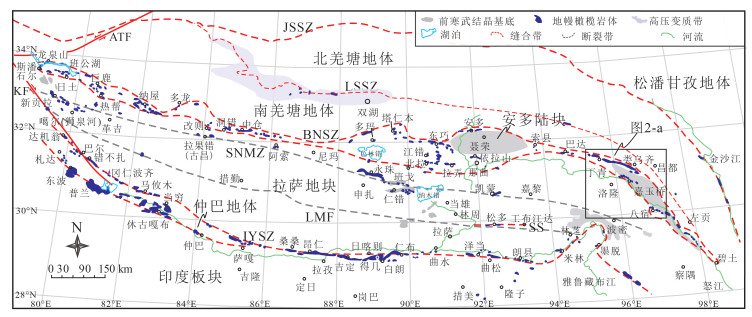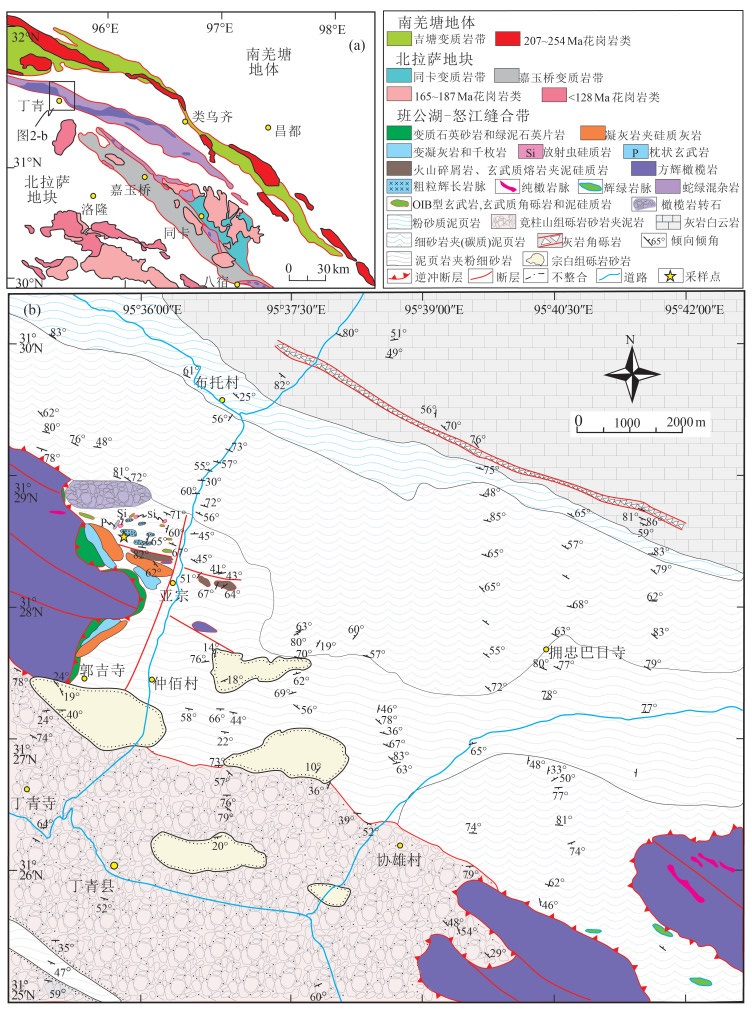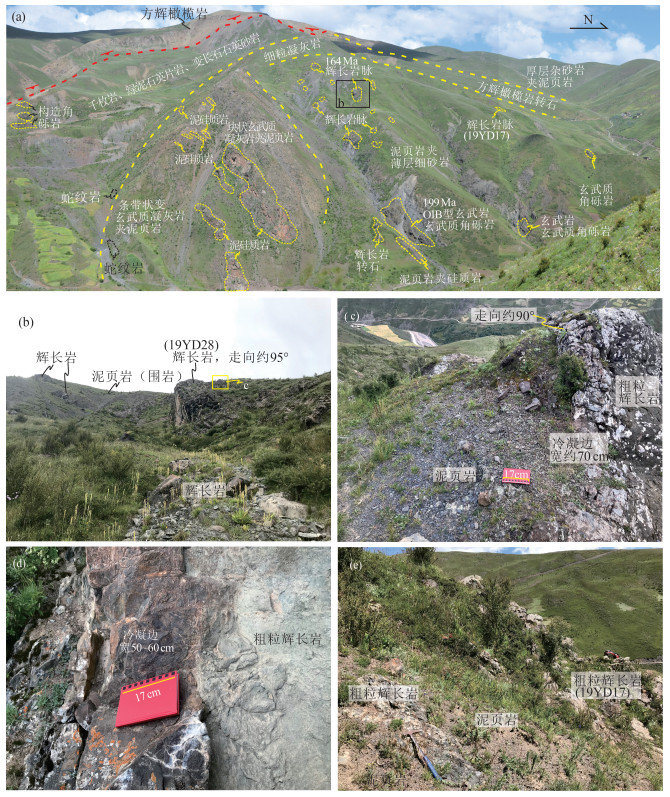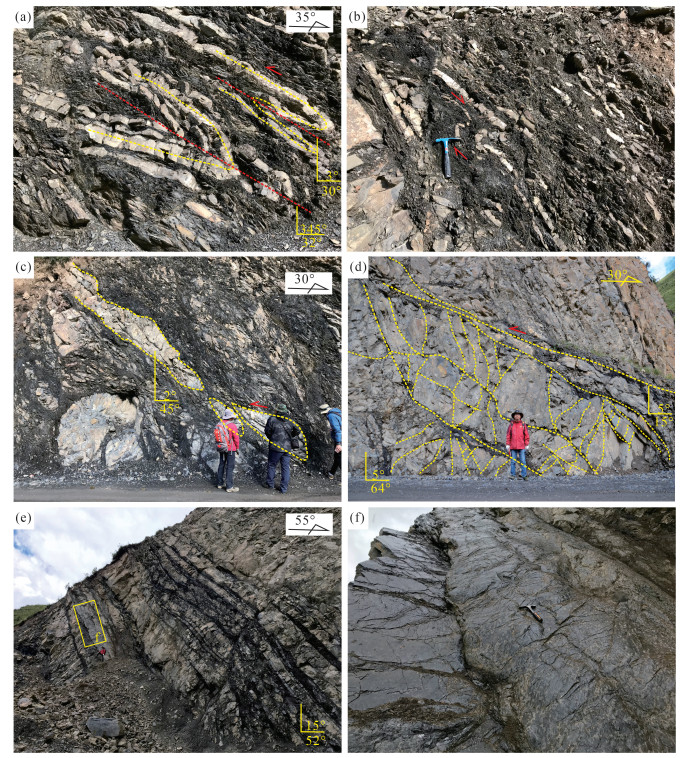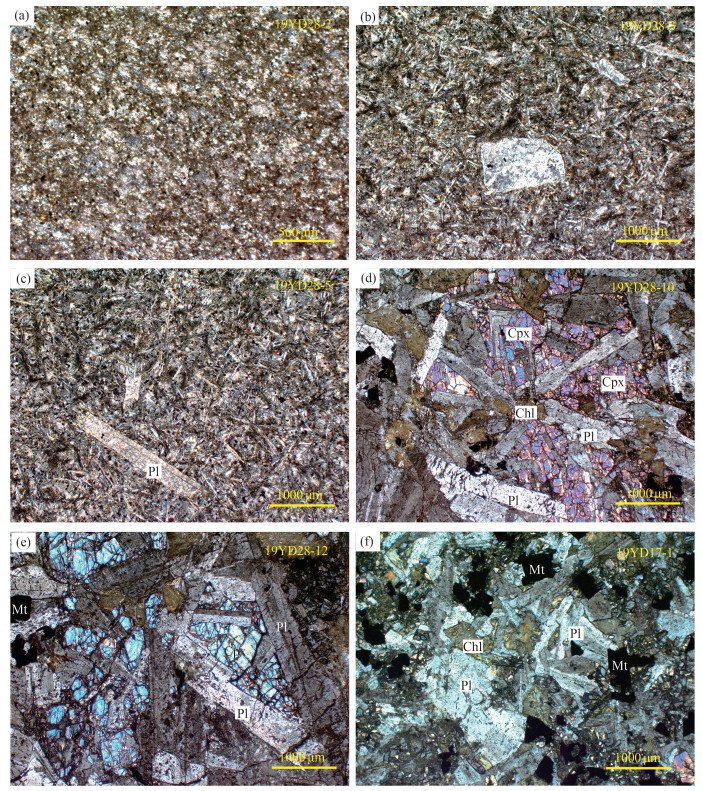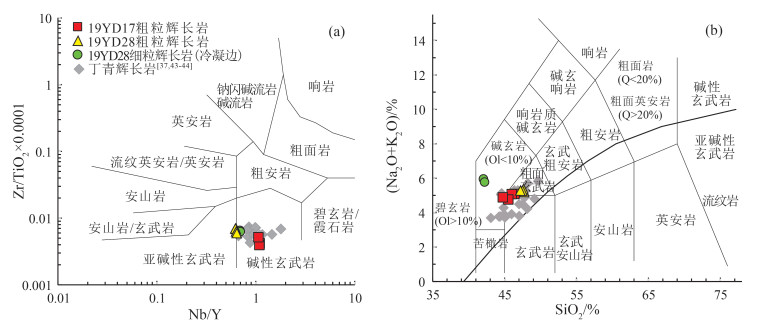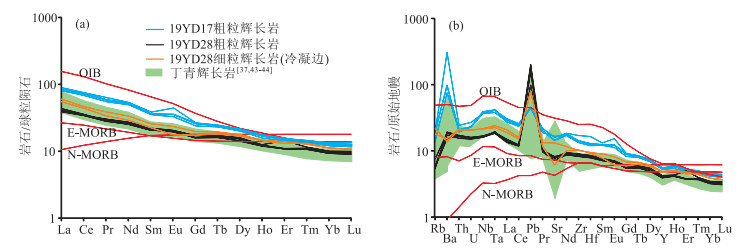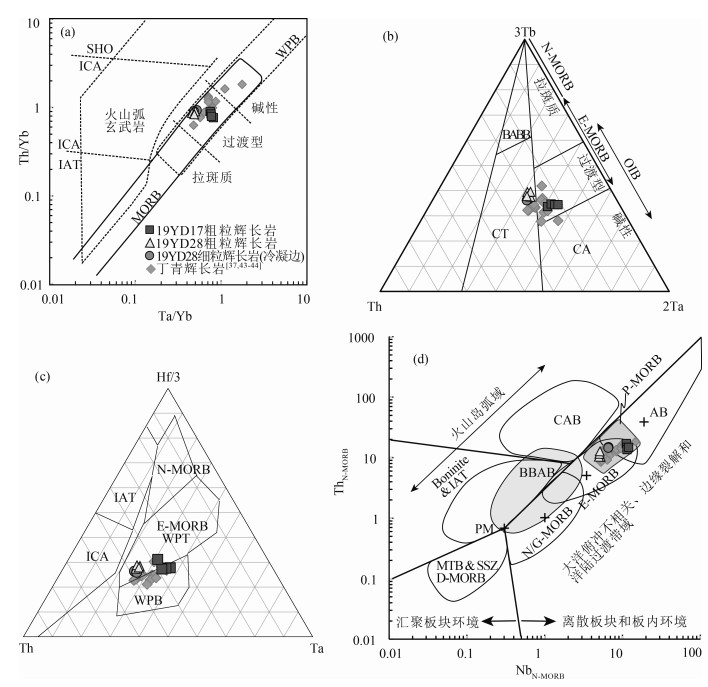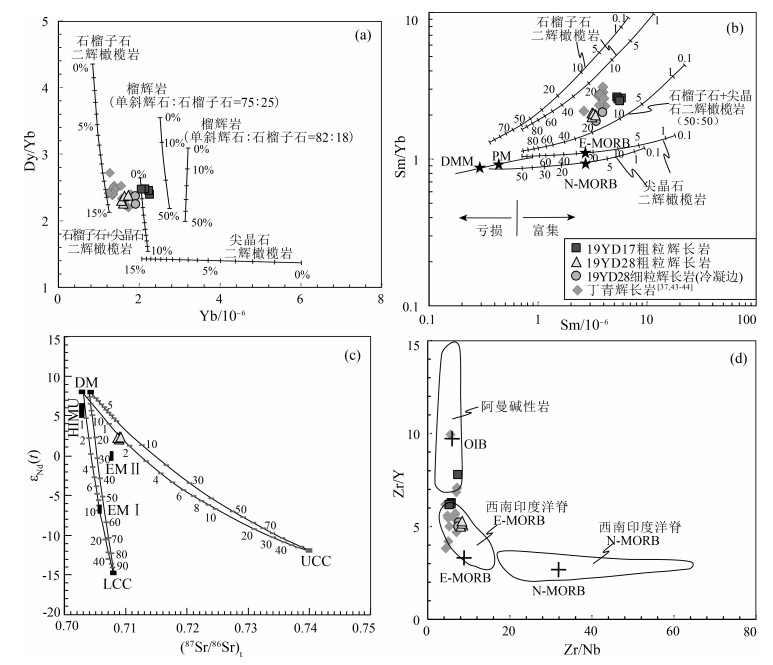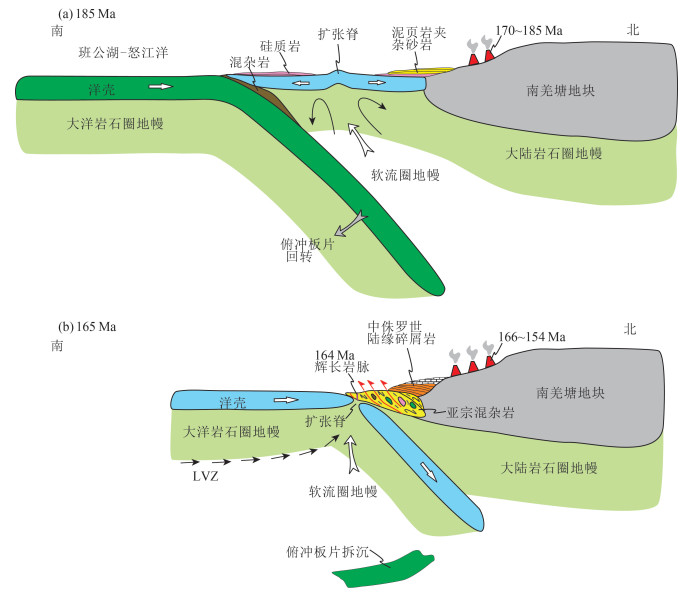Spreading ridge subduction of Bangong-Nujiang Ocean Evidence from geochemistry and Sr-Nd isotope of Middle Jurassic gabbro dikes in the Zongbai accretionary complex
-
摘要:
丁青蛇绿岩位于班公湖-怒江缝合带东段,被宗白增生杂岩分为东、西2个蛇绿岩体,面积分别约为400 km2和150 km2。宗白增生杂岩由异地体亚宗混杂岩和上部原地体陆缘碎屑沉积岩组成。亚宗混杂岩由低变质岩带、砾岩带、玄武质凝灰岩夹薄层泥硅质岩带和作为主要基质的泥页岩夹薄层杂砂岩组成,其中泥页岩基质被中侏罗世辉长岩脉侵入。辉长岩脉发育双侧冷凝边,走向90°~110°不等,主量、稀土和微量元素成分均介于富集型洋中脊玄武岩和洋岛玄武岩之间,结合εNd(t)=1.88~2.41和(87Sr/86Sr)t=0.70912 ~ 0.70919,指示宗白辉长岩岩浆为大洋岩石圈地幔底部地震波低速带(LVZ)顶部富集挥发分和不相容元素的洋岛玄武岩型熔体,与源自LVZ下部亏损软流圈地幔的正常洋中脊玄武岩型熔体混合的产物,形成于弧前扩张脊与俯冲带相互作用的板片窗环境。
Abstract:The Dingqing ophiolite, outcropped in the eastern segment of the Bangong-Nujiang suture zone, is divided into eastern part covering 400 km2 and western part covering 150 km2 by the Zongbai accretionary complex.The Zongbai accretionary complex is composed of the allogeneic Yazong mélange and the overlying autochthonous epicontinental clastic sedimentary rocks.The Yazong mélange consists of low metamorphic rock zone, conglomerate zone, basaltic tuff interlayered with thin layers of argillaceous siliceous rock, and argillaceous shale interbedded with thin layers of greywacke.The argillaceous rock is intruded by Middle Jurassic gabbro dikes with bilateral chill margins and striking 90°~110°.Compositions of major, rare earth and trace elements of all gabbro samples are between E-MORB and OIB.Combined with Nd isotope data of εNd(t) (1.88~2.41) and Sr data of (87Sr/86Sr) t(0.70912~0.70919), it is suggested that the gabbroic magmas are the product of the mixture of OIB-type melts rich in volatile and incompatible elements at the top of the seismic low-velocity zone(LVZ) and N-MORB-type melts originated from the lower part of LVZ.The gabbros were formed in a slab window setting during the interacting of the forearc spreading ridge within a subduction zone.
-
F是人体必需的微量元素,与人的健康息息相关。F具有双阈值性,饮用水和食物中氟的缺乏,会影响人和动物牙齿的发育,而氟过量则会造成氟中毒,产生骨硬化等症状[1]。土壤作为F元素的主要载体,通过食物链影响着人类的身体健康。
自然界岩石中的含氟矿物主要有萤石(CaF2)、氟磷灰石[Ca5(PO4)3F]、云母和闪石、冰晶石(Na3AlF6)、氟盐(NaF)和黄玉[Al2(SiO4)F2]及某些粘土[2-3],在成土母岩风化发育过程中,受到气候、生物等因素的影响,使F在土壤中重新分配[4]。此外,以气体(如HF、SiF4、F2、和H2SiF4)和颗粒(如CaF2、NaF和Na2SiF6)形式存在于大气中的F也会随着降雨进入土壤,使土壤中F的含量增加[5]。土壤中F元素含量也会受到人为活动的影响。由于F在工业生产中的广泛使用,大量的含F废弃物进入环境后,其中一部分直接或间接进入土壤;施肥、灌溉、喷洒农药等农业生产活动也是导致土壤F含量升高的重要因素[6-9]。土壤中F含量也与土壤类型和土壤理化性质有关,如pH值、有机碳含量、质地等[10-14]。
国内外对F的研究相对集中于饮水和大气中的氟污染[15-18],而对土壤F的研究较少。土壤F含量的高低直接关系着食物链中农作物品质和人类的饮食安全。因此,对土壤F的系统研究非常必要。山东省是中国受地方性氟中毒危害最严重的病区省份之一[19]。本次选择山东省主要生产大宗农作物玉米和小麦的吨粮县桓台为研究区,通过采集表层土壤样品,研究土壤F的地球化学分布特征及其影响因素,为改善研究区的环境质量,防止地方性氟中毒提供基础数据和科学依据。
1. 研究区概况
山东省桓台县地处鲁中山区和鲁北平原的结合地带,属淄博市辖县,位于山东省中部偏北,淄博市北部。该县地处黄河中下游鲁北平原南缘,地势南高北低,由西南向东北缓倾,中南部为山前倾斜洪冲积平原,北部为黄泛平原。地表覆盖300 m以上的古近纪—新近纪和第四纪松散岩层。该地区气候为温带大陆性季风型气候,四季分明,春季干旱多风;夏季有雨热同季的特点,雨水较多,气温炎热;秋季凉爽少雨;冬季寒冷干旱,多西北风。全年降水量在600 mm左右,除夏季外其他季节降水较少,多出现季节性干旱。研究区地理坐标为北纬36°51′50″~37°06′00″、东经117°50′00″~118°10′40″,土壤类型以褐土为主,其次为砂姜黑土,分布面积最小的土壤类型为潮土,主要作物为玉米和小麦。
2. 实验材料与方法
2.1 样品采集和处理
本次研究表层土壤样品采集密度为2件/4 km2;采集深度为0~20 cm,共采集70件样品。每个土壤样品采样时以GPS定位点为中心,向四周辐射50~100 m为分样采集点,3点等分组合成1件混合土样。3点的采样部位、深度及质量均保持一致。土壤样品采集优先选择分布面积最广的农业用地土壤,避开了明显点状污染的地段,以及新近搬运的堆积土、垃圾土、局部低洼地、高岗地、田埂等处,确保样品具有代表性。野外样品采集严格按照《多目标地球化学调查规范(1∶250 000)》(DD2005—01)[20]。采样点分布如图 1所示。
土壤样品置于室内通风处自然风干,并注意防止酸、碱等气体及灰尘污染。在风干过程中,适时翻动,并将大土块捏碎以加速干燥,同时剔除土壤以外的杂物;风干后的土壤样品,按照以下要求进行初加工:将风干后的样品平铺在制样板上,将植物残体、石块等侵入体和新生体剔除干净,采用静电吸附的方法清除细小已断的植物须根;土壤用木棍碾压,压碎的土样全部通过2 mm的孔径筛。
2.2 分析方法和数据处理方法
土壤样品测定F、有机碳含量、pH值等8项指标。测定过程在自然资源部武汉矿产资源监督检测中心完成。分析检测严格执行《区域生态地球化学评价规范》(DZ/T 0289—2015)[21]和《生态地球化学评价样品分析技术要求》(DD2005—3)[22]。采用电感耦合等离子体质谱法(ICP-MS)、全谱直读光谱法(ICP-OES)、X射线荧光光谱法(XRF)、原子荧光光谱法(AFS)、离子选择性电极法(ISE)、沉降法(VOL)、液相沉降法测定相关元素指标。测试过程中均采用国家一级标准物质的测试结果进行准确度(Δlg C)检验,实验室插入的重复样测试结果进行精密度(RD%)检验。准确度采用Δlg C=|lg Ci-lg Cs |检验,其中Ci为某标准样的某次测试结果,Cs为该标准样的标准值;精密度采用RD = | C1-C2 | /[(C1 +C2)/ 2]×100,C1和C2分别为基本分析样和重复样的测试结果。各指标的分析方法、单位、检出限、准确度Δlg C和精确度RD见表 1。上述各指标的准确度和精密度均符合要求。
表 1 样品中各指标的分析方法和检出限Table 1. Analysis method and detection limits for various indicators in samples指标 分析方法 检出限 准确度
Δlg C精确度
RD/%F ISE 30 mg/kg 0.01 0.78 Se AFS 0.01 mg/kg 0.01 4.51 CaO ICP-OES 0.0002% 0.01 5.20 pH ISE 0.01(无量纲) 0.04 1.64 有机碳 VOL 0.0002% 0.01 2.27 Cd ICP-MS 0.02 mg/kg 0.01 3.85 P XRF 5 mg/kg 0.01 0.58 粒度 液相沉降法 0.001% 0.01 3.21 数据处理使用SPSS 13.0软件进行统计分析,相关分析采用Pearson相关分析。地球化学图使用ArcGIS 10.2软件制作。
3. 结果与讨论
3.1 表层土壤理化性质和F含量特征
研究区表层土壤理化性质统计特征见表 2。研究区表层土壤均呈弱碱性至碱性(7.59~8.47)。表层土壤F含量的变化范围为466.30~793.40 mg/kg,平均含量为621.31 mg/kg,显著高于山东省(534 mg/kg)[23]和全国土壤F含量的背景值(478 mg/kg)[24]。
表 2 土壤理化性质统计特征Table 2. Statistics of physical and chemical properties of soils指标 最小值 最大值 平均值 标准差 变异系数 F/(mg·kg-1) 466.30 793.40 621.31 70.15 0.11 Se/(mg·kg-1) 0.08 0.56 0.29 0.07 0.24 CaO/ % 1.88 10.48 4.36 1.74 0.40 pH 7.59 8.47 - - - 有机碳/ % 0.25 2.38 1.46 0.35 0.24 Cd/(mg·kg-1) 0.10 0.29 0.18 0.04 0.22 P/(mg·kg-1) 433.50 2824.27 1374.54 427.31 0.31 根据《土地质量地球化学评价规范》(DZ/T0295—2016)中氟元素的等级标准,研究区81.4%表层土壤样品中F含量属于高和过剩。具体含量等级详见表 3。表明研究区土壤F含量偏高,具有潜在环境生态风险。
表 3 土壤氟丰缺划分界限值及对应样品数和比例Table 3. Soil fluorine division limit values and corresponding sample number and proportion含量分级 表土总F/(mg·kg-1) 样品数 所占比例/ % 缺乏 ≤400 0 0 边缘 >400~500 3 4.3 适量 >500~550 10 14.3 高 >550~700 48 68.5 过剩 >700 9 12.9 为进一步了解桓台地区土壤F含量水平,本次收集了中国有代表性的表层土壤全F含量进行比较(表 4)。桓台地区土壤F含量相比国内其他地区变化幅度较大,在一定程度上反映了后期人类活动对土壤F含量的贡献;研究区土壤F含量最小值相比其他地区较高,可能是桓台地区的成土母质中F含量较高所致。
表 4 中国部分地区土壤F含量对照Table 4. Fluorine content in soil of some districts in China3.2 表层土壤F含量的空间分布特征
通过ArcGIS 10.2中反距离权重法绘制研究区表层土壤F元素的地球化学图,可以直观地反映其空间分布特征。研究区表层土壤F含量的空间分布特征如图 2。研究区大部分土壤F含量较高(大于500 mg/kg),其面积约占研究区总面积的70%, 其中F含量过剩的土壤相对集中分布在城镇附近;研究区东南部青银高速附近和研究区的北部呈零星分布的土壤中F为适中及边缘含量水平。
3.3 表层土壤中F含量的影响因素
表层土壤中F含量一方面受到自然因素和人为因素的控制,另一方面受到土壤本身理化因素的影响。本文从成土母质、人为源和土壤理化性质3个方面讨论表层土壤中F含量的影响因素。
3.3.1 成土母质
成土母质受地质体本底含量的控制[8-9]。不同母质形成的土壤,F含量差异很大。即使同一种母质发育的土壤,由于成土过程的不同也会对土壤F含量产生影响[3]。为研究F的来源,本次研究采集土壤剖面1个,剖面中土壤样品10件。F元素在不同深度下对应的含量变化如图 3所示。由图 3可以看出,F元素从深层到表层含量变化不大,体现了明显的继承性。
3.3.2 人为源
表层土壤F含量除受自然来源影响外,还受到工业和农业的人为影响。工业生产活动(如钢铁、制铝、磷肥、玻璃、陶瓷、化工等含氟工业,磷矿的开采及加工,燃煤过程)排放出大量的含氟气体或尘粒等,通过降水、入渗、淋溶等过程直接或间接地把氟带入土壤。现代农业活动,如含氟磷肥、含氟农药及含氟灌溉水等也会使土壤中的F含量增加[33-36]。通量指单位时间内,通过单位面积的物质的量。大气沉降、灌溉水、化肥3种人为输入源中F元素输入通量的计算方法如下。
(1) 大气沉降
大气沉降通量是通过分析集尘装置内沉降物的F元素含量,结合集尘装置的面积,计算获得研究区单位面积的F沉降量。计算公式如下:
Q=C⋅W/S (1) 式中,Q为大气沉降F元素通量(μg/(m2·a));C为大气沉降中F元素的含量(mg/kg);W为大气沉降质量(g);S为集尘装置面积(m2)。该数据由山东省地质调查研究院提供,采集周期为一年。
(2) 灌溉水
桓台地区灌溉水用量数据来自山东省地质调查研究院,灌溉水体积为1.2341×1011 m3,实际灌溉面积为4.6498×1011 m2。灌溉水氟通量计算公式如下:
Q=1000C⋅V (2) 式中,Q为灌溉水中F元素通量(μg/(m2·a));C为灌溉水F元素含量(μg/L);V为灌溉水用量(m3/(m2·a))。
(3) 化肥
本次研究采集当地90%以上的化肥种类,在工区内选择1~2个销售点集中采样,获得代表性肥料样品。由于各种化肥的成分复杂,不能简单地将各种化肥等同对待,需要加权计算F元素的输入通量。本次根据不同种类化肥年使用量,分别计算了各种化肥的F元素输入通量然后加和。化肥中F元素输入通量计算公式如下:
G=n∑i=1Ci⋅Mi (3) 式中,G为化肥的F元素输入通量(g/(hm2·a)),Ci为第i种化肥中F元素含量(mg/kg),Mi为第i种化肥平均每公顷使用量(kg)。
桓台地区土壤不同来源F元素的输入通量的结果显示(图 4),化肥为主要输入途径,占总输入通量的89.7%,远高于大气沉降和灌溉水。
由此可见,桓台地区土壤中F含量除表现出明显的继承性外,还受到农业施肥的影响。
3.3.3 土壤理化性质
土壤中F含量除受到成土作用过程的控制外,还受到土壤本身理化性质的制约[10-14]。
(1) pH值
土壤pH值很大程度上决定土壤氟的活动性。F-(离子半径:0.136 nm)与OH-(离子半径:0.140nm)大小相近,具有相似的地球化学性质,土壤胶体和溶液中OH-和F-之间极易发生离子交换[37]。在碱性条件下,水解产物多为离子态氟,游离的OH-离子与Ca2+、Fe3+、Al3+等离子生成沉淀,减少了F-产生沉淀的机会,因此大大增加了土壤中氟的活性[29]。研究区表层F含量与pH值之间呈负相关关系(图 5),F与pH值在0.05水平(双侧)下显著相关,说明表层土壤中F含量与pH值关系密切。
(2) 有机碳
土壤总F含量与土壤有机碳含量一般呈正相关关系[38-41]。土壤有机碳中腐殖酸的复杂功能团连接着许多Fe3+、Al3+、Ca2+等阳离子,这些离子提供了氟吸附位。有机碳含量低的土壤,缺乏团粒结构,易渗漏,因此水溶态氟迁移作用强烈,使氟易进入深层土壤和地下水,因此有机碳含量越高,表层土壤F含量也越高[12]。研究区表层F含量随有机碳含量增加有升高的趋势(图 6),F与有机碳含量在0.01水平(双侧)下显著相关,说明表层土壤中F含量与有机碳含量关系非常密切。
(3) 质地
表层土壤F含量与质地有关。一般来说,F含量在砂性土壤中较低,在粘性土壤中较高。土壤颗粒大小与F含量成反比,即颗粒越粗,F含量越低;反之,F含量越高[12]。研究区F含量与砂粒含量之间呈负相关趋势,但并未达到显著性水平,这可能与研究区土壤质地变异程度较小有关。
(4) 其他元素(指标)
在风化成土的过程中,由于元素的地球化学性质不同,元素的迁移富集能力也不同。对F与其他元素(指标)进行Pearson相关性分析,结果显示Cd、P、Se和CaO与F显著相关(表 5)。
表 5 土壤氟含量与其他元素(指标)的相关性分析(n=70)Table 5. Correlation between soil fluorine contents and other elements(indicators)(n=70)元素(指标) Se Cd P CaO F 0.38** 0.47** 0.67** -0.33** 注:**表示在0.01水平(双侧)下显著相关 研究区土壤F含量与Se、P、Cd含量呈显著正相关关系,与CaO呈负相关关系。前人的研究结果也表明,土壤总氟受总磷、总镉、有机碳等因素的影响,与其呈正相关关系[42]。桓台是吨粮县,农业生产中使用大量磷肥,中国中小磷肥厂生产的磷肥含氟质量分数为10~16 g/kg[4]。因此,表层土壤中氟和磷的正相关关系也反映出它们受到农业施肥的影响。
为深入探讨与土壤F含量呈显著相关性的元素(指标)之间的关系,对F、Se、CaO和有机碳进行了偏相关分析(表 6)。将有机碳作为控制变量后,发现F和Se、CaO并未达到显著相关。这表明F与Se、CaO和有机碳呈现出显著相关性的原因是,F、Se和CaO三者的含量都与有机碳密切相关,所以引起了F与Se、CaO之间呈显著伪正相关关系。
表 6 土壤F、Se、CaO和有机碳的偏相关分析(n=70)Table 6. Partial correlation analysis of soil F, Se, CaO and organic carbon(n=70)控制变量 变量 F Se CaO 有机碳 F 1 Se 0.01 1 CaO -0.18 0.18 1 4. 结论
(1) 山东省桓台地区表层土壤F含量范围为466.30~793.40mg/kg,平均为621.31mg/kg,显著高于山东省背景值和全国背景值,且研究区81.4%的表层土壤样品中F含量属于高和过剩,表明研究区土壤F含量偏高,具有潜在环境生态风险。
(2) 山东省桓台地区大部分土壤F含量较高(大于500mg/kg),其面积约占研究区总面积的70%, 其中F含量过剩的土壤相对集中分布在城镇附近;研究区东南部青银高速附近和研究区的北部呈零星分布的土壤中,F为适中及边缘含量水平。
(3) 土壤中F元素成土母质的研究结果表明,研究区从深层到表层土壤F含量变化不大,体现了明显的继承性。
(4) 土壤中F元素人为源的研究结果表明,研究区土壤F含量受到大气沉降、灌溉水和农业施肥的影响,其中农业施肥的影响最显著。
(5) 表层土壤理化性质的研究结果可知,研究区表层土壤F含量与pH值呈负相关关系;与有机碳含量呈显著正相关关系;与Se、P、Cd含量呈显著正相关关系,与CaO呈负相关关系,表明山东省桓台地区表层土壤中F含量主要受控于pH、有机碳含量和施肥。
致谢: 论文撰写过程中,中国地质科学院地质研究所戚学祥、闫臻、何碧竹、冯光英、牛晓露、赵中宝、马绪宣等老师给予有益建议,西藏矿业发展股份有限公司巴登珠总工,中冶局第二地勘院郭腾飞、张凯、王国峰和郑源,西藏地矿局章奇志总工、次罗、杨江苏和李术江在野外工作中给予帮助,两位审稿专家给予非常好的修改建议,在此表示真挚地感谢。 -
图 1 班公湖-怒江缝合带(BNSZ)、狮泉河-纳木错混杂岩带(SNMZ)、印度河-雅鲁藏布江缝合带(IYSZ)蛇绿岩分布简图(据参考文献[17]修改)
ATF—阿尔金断裂;JSSZ—金沙江缝合带;KF—喀喇昆仑断裂;LMF—洛巴堆-米拉山断裂;LSSZ—龙木错-双湖-澜沧江缝合带;SS—松多缝合带
Figure 1. Tectonic outline of the Tibetan Plateau showing the distribution of ophiolites in Bangong -Nujiang Suture Zone(BNSZ), Shiquan River-Namtso Mélange Zone(SNMZ)and Indus-Yarlung Zangbo Suture Zone(IYSZ)
图 4 宗白增生杂岩中辉长岩脉球粒陨石标准化稀土元素配分模式图(a)和微量元素原始地幔标准化蛛网图(b)(球粒陨石、原始地幔数据、OIB、E-MORB和N-MORB数据据参考文献[50])
OIB—洋岛玄武岩;E-MORB—富集型洋中脊玄武岩;N-MORB—正常型洋中脊玄武岩
Figure 4. Chondrite normalized REE patterns(a)and primitive mantle normalized trace elements patterns(b) of the gabbro dikes from the Zongbai complex
图 5 宗白辉长岩构造判别图解
a—Ta/Yb-Th/Yb图解[57]; b—3Tb-Th-2Ta图解[54]; c—Hf/3-Th-Ta图解[58]; d—(Nb-Th)N-MORB[52]图解。AB—碱性玄武岩;BABB—弧后盆地玄武岩;CA—大陆碱性玄武岩;CAB—大陆岛弧玄武岩;CT—大陆拉斑玄武岩;D/E/G/N/P-MORB—亏损型/ 富集型/具有石榴子石信息的/正常/地幔柱型洋中脊玄武岩;ICA—岛弧钙碱性玄武岩;IAT—岛弧拉斑玄武岩;MTB—中钛玄武岩;PM—原始地幔;SHO—钾玄岩系列;WPB—板内玄武岩;WPT—板内拉斑玄武岩
Figure 5. Tectonic discrimination diagrams for the gabbro dikes from the Zongbai complex
图 6 宗白辉长岩Yb-Dy/Yb(a)[61]、Sm-Sm/Yb(b)[62]、(87Sr/86Sr)t - εNd(t)(c)[63]和Zr/Nb-Zr/Y(d)[60]图解(西南印度洋脊数据据参考文献[60],阿曼碱地岩数据据参考文献[64])
DM—亏损地幔;LCC—大陆下地壳;UCC—大陆上地壳;DMM—亏损洋中脊玄武岩型地幔;PM—原始地幔;N/E-MORB—正常/富集型洋中脊玄武岩;EMI—富集地幔I;EMII—富集地幔II;OIB—洋岛玄武岩
Figure 6. Yb-Dy/Yb(a), Sm-Sm/Yb(b), (87Sr/86Sr)t - εNd(t)(c) and Zr/Nb-Zr/Y(d) diagrams for the gabbro dikes from the Zongbai complex
表 1 宗白增生杂岩中辉长岩脉主量、微量和稀土元素含量
Table 1 Major, trace elements and REE compositions of the gabbros from the Zongbai accretionary complex
样品号 19YD17-1 19YD17-2 19YD17-3 19YD17-4 19YD28-3 19YD28-5 19YD28-7 19YD28-8 19YD28-10 19YD28-12 SiO2 46.02 45.52 46.39 44.75 42.23 42.07 47.34 47.67 47.79 47.60 TiO2 3.81 3.82 3.80 3.70 1.68 1.61 1.48 1.53 1.46 1.49 Al2O3 13.44 14.08 13.31 12.88 14.76 14.49 14.98 14.88 14.82 14.91 Fe2O3 6.69 7.19 7.08 7.12 2.53 3.02 3.54 3.67 3.45 3.05 FeO 8.09 7.92 7.76 7.65 8.24 7.05 7.76 7.90 8.04 8.39 MnO 0.20 0.21 0.20 0.20 0.23 0.33 0.19 0.20 0.20 0.19 MgO 6.31 6.18 5.87 5.96 4.89 4.96 8.72 9.12 8.87 8.92 CaO 5.81 5.79 5.92 7.29 8.89 9.54 5.11 4.51 4.89 4.50 Na2O 4.45 4.09 4.55 4.20 4.78 5.03 4.85 4.85 4.84 4.92 K2O 0.47 0.52 0.37 0.48 0.40 0.30 0.14 0.12 0.11 0.11 P2O5 0.30 0.31 0.31 0.30 0.19 0.19 0.16 0.16 0.17 0.17 烧失量 3.26 3.23 3.37 4.19 10.15 10.52 4.72 4.38 4.33 4.68 总计 99.75 99.73 99.77 99.59 99.89 99.88 99.86 99.87 99.86 99.87 TFeO 15.69 15.99 15.70 15.63 11.68 10.85 12.17 12.45 12.38 12.37 Sc 38.34 38.70 33.90 33.08 21.60 19.70 22.79 22.83 22.68 21.26 Cr 29.57 30.21 30.05 31.50 159.03 168.32 232.64 249.74 257.40 236.60 V 550.52 547.91 511.65 524.85 239.53 241.01 221.85 225.45 244.31 227.94 Ni 47.38 46.26 45.09 45.88 73.00 79.27 122.36 123.36 129.43 126.92 Co 53.92 56.29 54.28 54.39 49.42 40.75 50.43 51.65 54.25 55.27 Cu 115.40 114.60 105.08 103.53 95.28 104.69 132.56 127.14 146.56 135.21 Zn 158.73 162.32 157.47 150.69 127.14 137.84 138.04 134.71 140.71 147.83 Ga 19.05 19.74 18.57 19.47 19.50 21.28 19.25 20.01 20.41 21.62 Mo 0.75 0.74 0.70 0.69 0.59 0.48 0.20 0.18 0.19 0.16 Li 45.03 45.34 41.16 46.62 56.06 52.68 73.20 75.04 80.46 77.06 Be 0.94 1.00 0.92 0.89 1.77 1.57 0.86 0.81 1.06 0.79 Bi 0.04 0.04 0.03 0.04 0.02 0.01 0.03 0.04 0.01 0.03 Pb 3.15 3.24 3.22 3.22 5.69 5.63 14.28 11.22 6.97 11.98 Rb 11.68 12.52 8.72 11.83 14.08 11.42 4.74 3.71 3.38 3.59 Sr 302.67 304.50 350.27 339.42 129.31 278.66 173.82 151.20 169.70 163.08 Cs 0.61 0.72 0.47 0.52 0.90 0.66 0.59 0.55 0.47 0.51 Y 24.36 25.47 24.00 24.52 21.90 22.38 17.72 18.16 19.25 18.96 Zr 151.79 159.94 149.59 191.01 115.41 113.59 95.11 92.04 100.81 100.24 Nb 26.67 27.90 26.15 26.09 15.27 15.41 11.47 11.46 11.96 11.89 Cd 0.22 0.17 0.27 0.18 0.09 0.05 0.31 0.19 0.24 0.18 In 0.10 0.09 0.09 0.09 0.09 0.08 0.07 0.07 0.07 0.07 Tl 0.06 0.06 0.05 0.07 0.08 0.07 0.03 0.03 0.03 0.03 W 1.38 1.11 0.68 0.67 1.52 1.60 0.64 0.43 0.46 0.37 Ba 686.60 671.45 525.45 2140.75 95.91 106.59 128.75 121.27 134.66 107.43 La 18.71 19.99 19.02 21.08 13.00 14.29 9.37 9.26 9.77 10.30 Ce 43.58 44.69 41.55 45.73 26.95 28.53 21.55 20.90 21.08 21.85 Pr 5.49 5.59 5.21 6.02 3.23 3.67 2.70 2.66 2.87 2.75 Nd 23.27 24.42 23.00 24.91 13.65 15.67 11.87 11.80 12.70 12.38 Sm 5.42 5.54 5.38 5.87 3.46 3.96 3.16 3.16 3.40 3.27 Eu 2.03 2.07 1.89 2.57 1.03 1.36 1.15 1.13 1.19 1.14 Gd 5.26 5.39 4.90 5.45 3.56 4.05 3.24 3.28 3.54 3.32 Tb 0.89 0.91 0.86 0.92 0.68 0.73 0.60 0.61 0.64 0.63 Dy 5.26 5.45 5.06 5.42 4.30 4.52 3.64 3.60 4.04 3.87 Ho 0.94 0.95 0.88 0.99 0.81 0.83 0.68 0.68 0.71 0.70 Er 2.46 2.48 2.36 2.57 2.16 2.29 1.79 1.79 2.40 1.82 Tm 0.36 0.37 0.34 0.37 0.33 0.32 0.28 0.27 0.29 0.28 Yb 2.12 2.21 2.04 2.26 1.91 1.90 1.58 1.58 1.70 1.63 Lu 0.31 0.32 0.29 0.35 0.27 0.27 0.23 0.23 0.25 0.24 Hf 3.87 3.99 3.70 5.08 2.87 2.93 2.53 2.42 2.64 2.53 Ta 1.72 1.71 1.55 1.68 0.92 0.99 0.80 0.76 0.78 0.77 Th 1.64 1.78 1.74 2.06 1.76 1.80 1.39 1.32 1.45 1.46 U 0.49 0.49 0.48 0.57 0.43 0.43 0.32 0.32 0.34 0.33 注:主量元素含量单位为%,微量和稀土元素含量单位为10-6 表 2 宗白增生杂岩中辉长岩脉Sr、Nd同位素成分
Table 2 Sr and Nd isotopic compositions of the gabbros from the Zongbai accretionary complex
样品名称 19YD28-7 19YD28-8 19YD28-10 19YD28-12 样品名称 19YD28-7 19YD28-8 19YD28-10 19YD28-12 Rb 4.33 3.24 2.9 3.54 143Nd/144Nd 0.512722 0.512718 0.512711 0.512708 Sr 151.51 119.31 137.17 135.68 2σ 0.000009 0.000011 0.00001 0.000009 Sm 2.73 2.65 2.91 2.98 Sm/Nd 0.263984 0.278518 0.278133 0.281301 Nd 10.34 9.53 10.45 10.59 (143Nd/144Nd)t 0.512552 0.512539 0.512532 0.512541 87Rb/86Sr 0.083 0.078 0.061 0.075 εNd(0) 1.64 1.56 1.42 1.37 87Sr/86Sr 0.709352 0.709299 0.709332 0.709341 εNd(t) 2.41 2.15 2.02 1.88 2σ 0.000005 0.000006 0.000006 0.000006 2σ 0.088 0.107 0.098 0.088 (87Sr/86Sr)t 0.70916 0.709117 0.70919 0.709166 TDM 1208 1454 1470 1544 147Sm/144Nd 0.1595 0.168282 0.168049 0.169964 TDMC 755 776 787 788 注:TDM为亏损地幔模式年龄;TDMC为相对于CHUR(球粒陨石均一储源)的亏损地幔模式年龄;校正年龄t=164 Ma,国际标样BHVO-1的87Sr/86Sr推荐值为0.70347(2σ=0.0002),143Nd/144Nd推荐值为0.51298(2σ=0.00003),87Sr/86Sr实测值为0.703485(2σ=0.000006), 143Nd/144Nd实测值为0.512984(2σ=0.000006);国际标样BCR-2的87Sr/86Sr推荐值为0.70501(2σ=0.0002),143Nd/144Nd推荐值为0.51263(2σ=0.00002),87Sr/86Sr实测值为0.705074(2σ=0.000009),143Nd/144Nd实测值为0.512626(2σ=0.000006) -
Mckenzie D P, Morgan W J. Evolution of TripleJunctions[J]. Nature, 1969, 224(5215): 125-133. doi: 10.1038/224125a0
Palmer H. East Pacific Rise and Westward Drift of North America[J]. Nature, 1968, 220(5165): 341-345. doi: 10.1038/220341a0
Thorkelson D J. Ridge Subduction and SlabWindows[C]//Alderton D, Elias S A. Encyclopedia of Geology(Second Edition). Oxford: Academic Press, 2021: 957-967.
孙卫东, 凌明星, 杨晓勇, 等. 洋脊俯冲与斑岩铜金矿成矿[J]. 中国科学: 地球科学, 2010, 40(2): 127-137. doi: 10.3969/j.issn.1000-3045.2010.02.002 Cole R B, Stewart B W. Continental margin volcanism at sites of spreading ridge subduction: Examples from southern Alaska and western California[J]. Tectonophysics, 2009, 464(1/4): 118-136. http://www.sciencedirect.com/science/article/pii/S0040195107004519
Li S, Wang Q, Zhu D, et al. Reconciling Orogenic Drivers for the Evolution of the Bangong-Nujiang Tethys During Middle-Late Jurassic[J]. Tectonics, 2020, 39(2): e2019T-e5951T. http://www.researchgate.net/publication/338768096_Reconciling_Orogenic_Drivers_for_the_Evolution_of_the_Bangong-Nujiang_Tethys_During_Middle-Late_Jurassic
Liu X, Xiao W, Xu J, et al. Geochemical signature and rock associations of ocean ridge-subduction: Evidence from the Karamaili Paleo-Asian ophiolite in east Junggar, NW China[J]. Gondwana Research, 2017, 48: 34-49. doi: 10.1016/j.gr.2017.03.010
Madsen J K, Thorkelson D J, Friedman R M, et al. Cenozoic to Recent plate configurations in the Pacific Basin; ridge subduction and slab window magmatism in western North America[J]. Geological Society of America, 2006, 2: 11-34. http://adsabs.harvard.edu/abs/2006Geosp...2...11M
Thorkelson D J. Subduction of diverging plates and the principles of slab window formation[J]. Tectonophysics, 1996, 255(1/2): 47-63. http://www.sciencedirect.com/science/article/pii/0040195195001069
沈晓明, 张海祥, 马林. 洋脊俯冲及其在新疆阿尔泰地区存在的可能证据[J]. 大地构造与成矿学, 2010, 34(2): 181-195. doi: 10.3969/j.issn.1001-1552.2010.02.004 马本俊, 吴时国, 范建柯. 板片窗构造研究综述[J]. 海洋地质前沿, 2015, 31(12): 1-10. https://www.cnki.com.cn/Article/CJFDTOTAL-HYDT201512001.htm Fan J, Li C, Sun Z, et al. Early Cretaceous MORB-type basalt and A-type rhyolite in northern Tibet: Evidence for ridge subduction in the Bangong-Nujiang Tethyan Ocean[J]. Journal of Asian Earth Sciences, 2018, 154: 187-201. doi: 10.1016/j.jseaes.2017.12.020
张丽鹏, 李贺, 王鲲. 板块俯冲与斑岩铜金成矿[J]. 岩石学报, 2020, 36(1): 113-124. https://www.cnki.com.cn/Article/CJFDTOTAL-YSXB202001012.htm Sisson V B, Pavlis T L, Roeske S M, et al. Introduction: An overview of ridge-trench interactions in modern and ancient settings[C]//Sisson V B, Roeske S M, Pavlis T L, et al. Geology of a transpressional orogen developed during ridge-trench interaction along the North Pacific margin. Boulder, Colarado, Geological Society of America Special Paper, 2003, 371: 1-18.
Li S, Yin C, Guilmette C, et al. Birth and demise of the Bangong-Nujiang Tethyan Ocean: A review from the Gerze area of central Tibet[J]. Earth-Science Reviews, 2019, 198: 102907. doi: 10.1016/j.earscirev.2019.102907
Peng Y, Yu S, Li S, et al. The odyssey of Tibetan Plateau accretion prior to Cenozoic India-Asia collision: Probing the Mesozoic tectonic evolution of the Bangong-Nujiang Suture[J]. Earth-Science Reviews, 2020, 211: 103376. doi: 10.1016/j.earscirev.2020.103376
刘飞, 杨经绥, 连东洋, 等. 青藏高原新特提斯蛇绿岩的地质特征及其构造演化[J]. 岩石学报, 2020, 36(10): 2913-2945. https://www.cnki.com.cn/Article/CJFDTOTAL-YSXB202010001.htm Kapp P, Decelles P G. Mesozoic-Cenozoic geological evolution of the Himalayan-Tibetan orogen and working tectonic hypotheses[J]. American Journal of Science, 2019, 319(3): 159-254. doi: 10.2475/03.2019.01
许志琴, 杨经绥, 侯增谦, 等. 青藏高原大陆动力学研究若干进展[J]. 中国地质, 2016, 43(1): 1-42. https://www.cnki.com.cn/Article/CJFDTOTAL-DIZI201601001.htm Xu Z, Dilek Y, Cao H, et al. Paleo-Tethyan evolution of Tibet as recorded in the East Cimmerides and WestCathaysides[J]. Journal of Asian Earth Sciences, 2015, 105: 320-337. doi: 10.1016/j.jseaes.2015.01.021
Bai W, Zhou M, Robinson P T. Possibly diamond-bearing mantle peridotites and podiform chromitites in the Luobusa and Donqiao ophiolites, Tibet[J]. Canadian Journal of Earth Sciences, 1993, 30(8): 1650-1659. doi: 10.1139/e93-143
Wang W, Wang M, Zhai Q, et al. Transition from oceanic subduction to continental collision recorded in the Bangong-Nujiang suture zone: Insights from Early Cretaceous magmatic rocks in the north-central Tibet[J]. Gondwana Research, 2020, 78: 77-91. doi: 10.1016/j.gr.2019.09.008
陈言飞. 青藏高原东南部(昌都-察隅) 早中生代岩浆-变质作用及构造意义[D]. 中国地质大学(北京) 博士学位论文, 2019. Peng Y, Yu S, Li S, et al. Early Jurassic and Late Cretaceous granites in the Tongka micro-block, Central Tibet: Implications for the evolution of the Bangong-Nujiang ocean[J]. Journal of Asian Earth Sciences, 2020, 194: 104030. doi: 10.1016/j.jseaes.2019.104030
郑一义. 西藏丁青地区蛇绿岩-混杂岩的发现[C]//青藏高原地质文集(13). 北京: 地质出版社, 1983: 177-189. 王玉净, 王建平, 刘彦明, 等. 西藏丁青蛇绿岩特征、时代及其地质意义[J]. 微体古生物学报, 2002, (4): 417-420. doi: 10.3969/j.issn.1000-0674.2002.04.009 李观龙, 杨经绥, 薄容众, 等. 西藏班公湖-怒江缝合带东段丁青蛇绿岩中的铬铁矿: 产出特征与类型[J]. 中国地质, 2019, 46(1): 1-20. https://www.cnki.com.cn/Article/CJFDTOTAL-DIZI201901002.htm 李达周, 张旗, 张魁武. 西藏丁青地区与玻镁安山岩类有关的蛇绿岩的矿物学特征[J]. 岩石矿物学杂志, 1988, (3): 235-243. https://www.cnki.com.cn/Article/CJFDTOTAL-YSKW198803006.htm 张旗. 丁青蛇绿岩新知[J]. 地质科学, 1983, 18(1): 101-102. https://www.cnki.com.cn/Article/CJFDTOTAL-DZKX198301010.htm 邹光富. 西藏丁青蛇绿岩岩石地球化学特征及其成因意义[J]. 西藏地质, 1993, 10(2): 46-58. 张旗, 杨瑞英. 西藏丁青蛇绿岩中玻镁安山岩类的深成岩及其地质意义[J]. 科学通报, 1985, (16): 1243-1245. https://www.cnki.com.cn/Article/CJFDTOTAL-KXTB198516012.htm 刘文斌, 钱青, 岳国利, 等. 西藏丁青弧前蛇绿岩的地球化学特征[J]. 岩石学报, 2002, 18(3): 392-400. https://www.cnki.com.cn/Article/CJFDTOTAL-YSXB200203014.htm 林靓. 西藏丁青蛇绿岩的形成时代与岩石地球化学特征[D]. 中国科学院大学硕士学位论文, 2015. 李观龙. 班公湖-怒江缝合带东段丁青蛇绿岩地幔橄榄岩和铬铁矿特征[D]. 中国地质大学(北京) 硕士学位论文, 2019. 强巴扎西, 谢尧武, 吴彦旺, 等. 藏东丁青蛇绿岩中堆晶辉长岩锆石SIMS U-Pb定年及其意义[J]. 地质通报, 2009, 28(9): 1253-1258. http://dzhtb.cgs.cn/gbc/ch/reader/view_abstract.aspx?file_no=20090913&flag=1 Wang B, Wang L, Chung S, et al. Evolution of the Bangong-Nujiang Tethyan ocean: Insights from the geochronology and geochemistry of mafic rocks within ophiolites[J]. Lithos, 2016, 245: 18-33. doi: 10.1016/j.lithos.2015.07.016
李小波. 班公湖-怒江结合带安多-丁青蛇绿岩地球化学特征及构造演化研究[D]. 中国地质大学(北京) 硕士学位论文, 2016. 王玉净, 王建平, 裴放. 西藏丁青蛇绿岩带中一个晚三叠世放射虫动物群[J]. 微体古生物学报, 2002, (4): 323-336. doi: 10.3969/j.issn.1000-0674.2002.04.001 王建平, 刘彦明, 李秋生, 等. 西藏班公湖-丁青蛇绿岩带东段侏罗纪盖层沉积的地层划分[J]. 地质通报, 2002, 21(7): 405-410. http://dzhtb.cgs.cn/gbc/ch/reader/view_abstract.aspx?file_no=200207103&flag=1 Raymond L A. Perspectives on the roles of melanges in subduction accretionary complexes: A review[J]. Gondwana Research, 2019, 74: 68-89. doi: 10.1016/j.gr.2019.03.005
闫臻, 王宗起, 付长垒, 等. 混杂岩基本特征与专题地质填图[J]. 地质通报, 2018, 37(2/3): 167-191. http://dzhtb.cgs.cn/gbc/ch/reader/view_abstract.aspx?file_no=2018020301&flag=1 闫臻, 付长垒, 张继恩, 等. 混杂岩地质调查与填图方法[M]. 北京: 地质出版社, 2020: 1-80. 韦振权, 夏斌, 周国庆, 等. 西藏丁青宗白蛇绿混杂岩地球化学特征及其洋中脊叠加洋岛的成因[J]. 地质论评, 2007, (2): 187-197. doi: 10.3321/j.issn:0371-5736.2007.02.006 薄容众, 杨经绥, 李观龙, 等. 班怒带东段丁青蛇绿岩中镁铁质岩石年代学及构造背景[J]. 地质学报, 2019, 93(10): 2617-2638. doi: 10.3969/j.issn.0001-5717.2019.10.015 Mattinson J M, Echeverria L M. Ortigalita Peak gabbro, Franciscan Complex: U-Pb dates of intrusion and high-pressure-low-temperature metamorphism[J]. Geology, 1980, 8(12): 589-593. doi: 10.1130/0091-7613(1980)8<589:OPGFCU>2.0.CO;2
曾敏, 陈建平, 位冲冲. 木嘎岗日岩群是羌塘南缘的增生楔杂岩[J]. 地学前缘, 2017, 24(5): 207-217. https://www.cnki.com.cn/Article/CJFDTOTAL-DXQY201705025.htm Winchester J A, Floyd P A. Geochemical discrimination of different magma series and their differentiation products using immobileelements[J]. Chemical geology, 1977, 20: 325-343. doi: 10.1016/0009-2541(77)90057-2
Le Maitre R W, Streckeisen A, Zanettin B, et al. Igneous Rocks: A classification and glossary of terms: Recommendations of the International Union of Geological Sciences Subcommission on the Systematics of Igneous Rocks[M]. New York: Cambridge University Press, 2002: 1-236.
Liu F, Yang J, Dilek Y, et al. Geochronology and geochemistry of basaltic lavas in the Dongbo andPurang ophiolites of the Yarlung-Zangbo Suture zone: Plume-influenced continental margin-type oceanic lithosphere in southern Tibet[J]. Gondwana Research, 2015, 27(2): 701-718. doi: 10.1016/j.gr.2014.08.002
Sun S S, Mcdonough W F. Chemical and isotopic systematics of oceanic basalts: implications for mantle composition andprocesses[J]. Geological Society, London, Special Publications, 1989, 42(1): 313-345. doi: 10.1144/GSL.SP.1989.042.01.19
刘飞, 杨经绥, 陈松永, 等. 雅鲁藏布江缝合带西段基性岩地球化学和Sr-Nd-Pb同位素特征: 新特提斯洋内俯冲的证据[J]. 中国地质, 2013, 40(3): 361-374. https://www.cnki.com.cn/Article/CJFDTOTAL-DIZI201303008.htm Saccani E. A new method of discriminating different types of post-Archean ophiolitic basalts and their tectonic significance using Th-Nb and Ce-Dy-Yb systematics[J]. Geoscience Frontiers, 2015, 6(4): 481-501. doi: 10.1016/j.gsf.2014.03.006
Li C, Arndt N T, Tang Q, et al. Trace element indiscrimination diagrams[J]. Lithos, 2015, 232: 76-83. doi: 10.1016/j.lithos.2015.06.022
Xia L, Li X. Basalt geochemistry as a diagnostic indicator of tectonic setting[J]. Gondwana Research, 2019, 65: 43-67. doi: 10.1016/j.gr.2018.08.006
杨婧, 王金荣, 张旗, 等. 全球岛弧玄武岩数据挖掘——在玄武岩判别图上的表现及初步解释[J]. 地质通报, 2016, 35(12): 1937-1949. http://dzhtb.cgs.cn/gbc/ch/reader/view_abstract.aspx?file_no=20161201&flag=1 刘飞, 连东洋, 牛晓露, 等. 雅鲁藏布江缝合带西段东波MORB型均质辉长岩的大洋核杂岩成因[J]. 地球科学, 2018, 43(4): 952-974. https://www.cnki.com.cn/Article/CJFDTOTAL-DQKX201804003.htm Pearce J A. Supra-subduction zone ophiolites: The search for modernanalogues[J]. Special Papers-Geological Society of America, 2003: 269-294.
Wood D A. The application of a Th-Hf-Ta diagram to problems of tectonomagmatic calssification adn to establishing the nature of crustal contamination of basaltic lavas of the British Tertiary volcanic province[J]. Earth and planetary science letters, 1980, 50(1): 11-30. doi: 10.1016/0012-821X(80)90116-8
Condie K C. Incompatible element ratios in oceanic basalts and komatiites: Tracking deep mantle sources and continental growth rates withtime[J]. Geochemistry Geophysics Geosystems, 2013, 4(1): 1-28. doi: 10.1029/2002GC000333
Saccani E, Allahyari K, Beccaluva L, et al. Geochemistry and petrology of the Kermanshah ophiolites(Iran): Implication for the interaction between passive rifting, oceanic accretion, and OIB-type components in the Southern Neo-Tethys Ocean[J]. Gondwana Research, 2013, 24: 392-411. doi: 10.1016/j.gr.2012.10.009
An A, Choi S H, Yu Y, et al. Petrogenesis of Late Cenozoic basaltic rocks from southern Vietnam[J]. Lithos, 2017, 272/273: 192-204. doi: 10.1016/j.lithos.2016.12.008
Aldanmaz E, Pearce J A, Thirlwall M F, et al. Petrogenetic evolution of late Cenozoic, post-collision volcanism in western Anatolia, Turkey[J]. Journal of Volcanology and Geothermal Research, 2000, 102(1/2): 67-95. http://www.sciencedirect.com/science/article/pii/S0377027300001827
冯光英, 刘燊, 冯彩霞, 等. 吉林红旗岭超基性岩体的锆石U-Pb年龄、Sr-Nd-Hf同位素特征及岩石成因[J]. 岩石学报, 2011, (6): 1594-1606. https://www.cnki.com.cn/Article/CJFDTOTAL-YSXB201106003.htm Chauvet F, Lapierre H, Maury R C, et al. Triassic alkaline magmatism of the Hawasina Nappes: Post-breakup melting of the Oman lithospheric mantle modified by the Permian Neotethyan Plume[J]. Lithos, 2011, 122(1/2): 122-136. http://www.sciencedirect.com/science/article/pii/S002449371000349X
Gamal El Dien H, Doucet L S, Li Z, et al. Global geochemical fingerprinting of plume intensity suggests coupling with the supercontinent cycle[J]. Nature Communications, 2019, 10(1): 5270. doi: 10.1038/s41467-019-13300-4
牛耀龄. 板内洋岛玄武岩(OIB) 成因的一些基本概念和存在的问题[J]. 科学通报, 2010, (2): 103-114. https://www.cnki.com.cn/Article/CJFDTOTAL-KXTB201002002.htm 牛耀龄. 全国构造与地球动力学-岩石学与地球动力学方法应用实例[J]. 北京: 科学出版社. 2013: 1-307. Xu W, Li C, Wang M, et al. Subduction of a spreading ridge within the Bangong Co-Nujiang Tethys Ocean: Evidence from Early Cretaceous mafic dykes in the Duolong porphyry Cu-Au deposit, western Tibet[J]. Gondwana Research, 2017, 41: 128-141. doi: 10.1016/j.gr.2015.09.010
吴建亮, 尹显科, 刘文, 等. 西藏班公湖-怒江缝合带西段野马去申拉组富Nb火山岩的发现及其指示意义[J]. 地质通报, 2019, 38(4): 5-17. http://dzhtb.cgs.cn/gbc/ch/reader/view_abstract.aspx?file_no=20190401&flag=1 Wei S, Tang J, Song Y, et al. Early Cretaceous bimodal volcanism in the Duolong Cu mining district, western Tibet: Record of slab breakoff that triggered ca. 108-113 Ma magmatism in the western Qiangtang terrane[J]. Journal of Asian Earth Sciences, 2017, 138: 588-607. doi: 10.1016/j.jseaes.2016.12.010
Xu W, Li C, Xu M J, et al. Petrology, geochemistry, and geochronology of boninitic dikes from the Kangqiong ophiolite: implications for the Early Cretaceous evolution of Bangong-Nujiang Neo-Tethys Ocean in Tibet[J]. International Geology Review, 2015, 57(16): 2028-2043. doi: 10.1080/00206814.2015.1050464
Shi R, Yang J, Xu Z, et al. Discovery of the boninite series volcanic rocks in the Bangong Lake ophiolite mélange, western Tibet, and its tectonici mplications[J]. Chinese Science Bulletin, 2004, 12: 1272-1278.
Yang Z, Wang Q, Hao L, et al. Subduction erosion and crustal material recycling indicatedby adakites in central Tibet[J]. Geology, 2021. https://doi.org/10.1130/G48486.1
Li H, Wang M, Zeng X, et al. Generation of Jurassic high-Mg diorite and plagiogranite intrusions of the Asa area, Tibet: Products of intra-oceanic subduction of the Meso-Tethys Ocean[J]. Lithos, 2020, 362/363: 105481. doi: 10.1016/j.lithos.2020.105481
Ma Y, Zhong Y, Furnes H, et al. Origin and tectonic implications of boninite dikes in the Shiquanhe ophiolite, western Bangong Suture, Tibet[J]. Journal of Asian Earth Sciences, 2021, 205: 104594. doi: 10.1016/j.jseaes.2020.104594
Ducea M N, Saleeby J B, Bergantz G. The Architecture, Chemistry, and Evolution of Continental Magmatic Arcs[J]. Annual Review of Earth and Planetary Sciences, 2015, 43(1): 299-331. doi: 10.1146/annurev-earth-060614-105049
肖文交, 李继亮, 宋东方, 等. 增生型造山带结构解析与时空制约[J]. 地球科学, 2019, 44(5): 1661-1687. https://www.cnki.com.cn/Article/CJFDTOTAL-DQKX201905019.htm Dilek Y, Furnes H. Tethyan ophiolites and Tethyanseaways[J]. Journal of the Geological Society, 2019, 176(5): 899-912. doi: 10.1144/jgs2019-129
吴福元, 万博, 赵亮, 等. 特提斯地球动力学[J]. 岩石学报, 2020, 36(6): 1627-1674. https://www.cnki.com.cn/Article/CJFDTOTAL-YSXB202006001.htm Liu T, Zhai Q, Wang J, et al. Tectonic significance of the Dongqiao ophiolite in the north-central Tibetan plateau: Evidence from zircon dating, petrological, geochemical and Sr-Nd-Hf isotopic characterization[J]. Journal of Asian Earth Sciences, 2016, 116: 139-154. doi: 10.1016/j.jseaes.2015.11.014
Yan L, Zhang K. Infant intra-oceanic arc magmatism due to initial subduction induced by oceanic plateau accretion: A case study of the Bangong Meso-Tethys, central Tibet, western China[J]. Gondwana Research, 2020, 79: 110-124. doi: 10.1016/j.gr.2019.08.008
徐建鑫, 李才, 范建军, 等. 西藏改则县拉果错蛇绿岩构造属性: 来自岩石学、地球化学、年代学及Lu-Hf同位素的制约[J]. 地质通报, 2018, 37(8): 1541-1553. http://dzhtb.cgs.cn/gbc/ch/reader/view_abstract.aspx?file_no=20180818&flag=1 Zeng X, Wang M, Li C, et al. Lower Cretaceous turbidites in the Shiquanhe-Namco Ophiolite Mélange Zone, Asa area, Tibet: Constraints on the evolution of the Meso-Tethys Ocean[J]. Geoscience Frontiers, 2021, 12(4): 101127. doi: 10.1016/j.gsf.2020.12.008
Xu M, Li C, Zhang X, et al. Nature and evolution of the Neo-Tethys in central Tibet: synthesis of ophiolitic petrology, geochemistry, and geochronology[J]. International Geology Review, 2014, 9(56): 1072-1096.
刘一鸣, 李三忠, 于胜尧, 等. 青藏高原班公湖-怒江缝合带及周缘燕山期微地块聚合与增生造山过程[J]. 大地构造与成矿学, 2019, 43(4): 824-838. https://www.cnki.com.cn/Article/CJFDTOTAL-DGYK201904014.htm Zhu D, Li S, Cawood P A, et al. Assembly of the Lhasa and Qiangtang terranes in central Tibet by divergent double subduction[J]. Lithos, 2016, 245: 7-17. doi: 10.1016/j.lithos.2015.06.023
Lai W, Hu X, Zhu D, et al. Discovery of the early Jurassic Gajia mélange in the Bangong-Nujiang suture zone: Southward subduction of the Bangong-Nujiang Ocean?[J]. International Journal of Earth Sciences, 2017, 106(4): 1277-1288. doi: 10.1007/s00531-016-1405-1
Tang Y, Zhai Q, Hu P, et al. Southward subduction of the Bangong-Nujiang Tethys Ocean: insights from ca. 161-129 Ma arc volcanic rocks in the north of Lhasa terrane, Tibet[J]. International Journal of Earth Sciences, 2020, 109(2): 631-647. doi: 10.1007/s00531-020-01823-x
曲晓明, 王瑞江, 辛洪波, 等. 西藏西部与班公湖特提斯洋盆俯冲相关的火成岩年代学和地球化学[J]. 地球化学, 2009, 38(6): 523-535. doi: 10.3321/j.issn:0379-1726.2009.06.002 Fan J, Li C, Sun Z, et al. Early Cretaceous MORB-type basalt and A-type rhyolite in northern Tibet: Evidence for ridge subduction in the Bangong-Nujiang Tethyan Ocean[J]. Journal of Asian Earth Sciences, 2018, 154: 187-201. doi: 10.1016/j.jseaes.2017.12.020




 下载:
下载:





